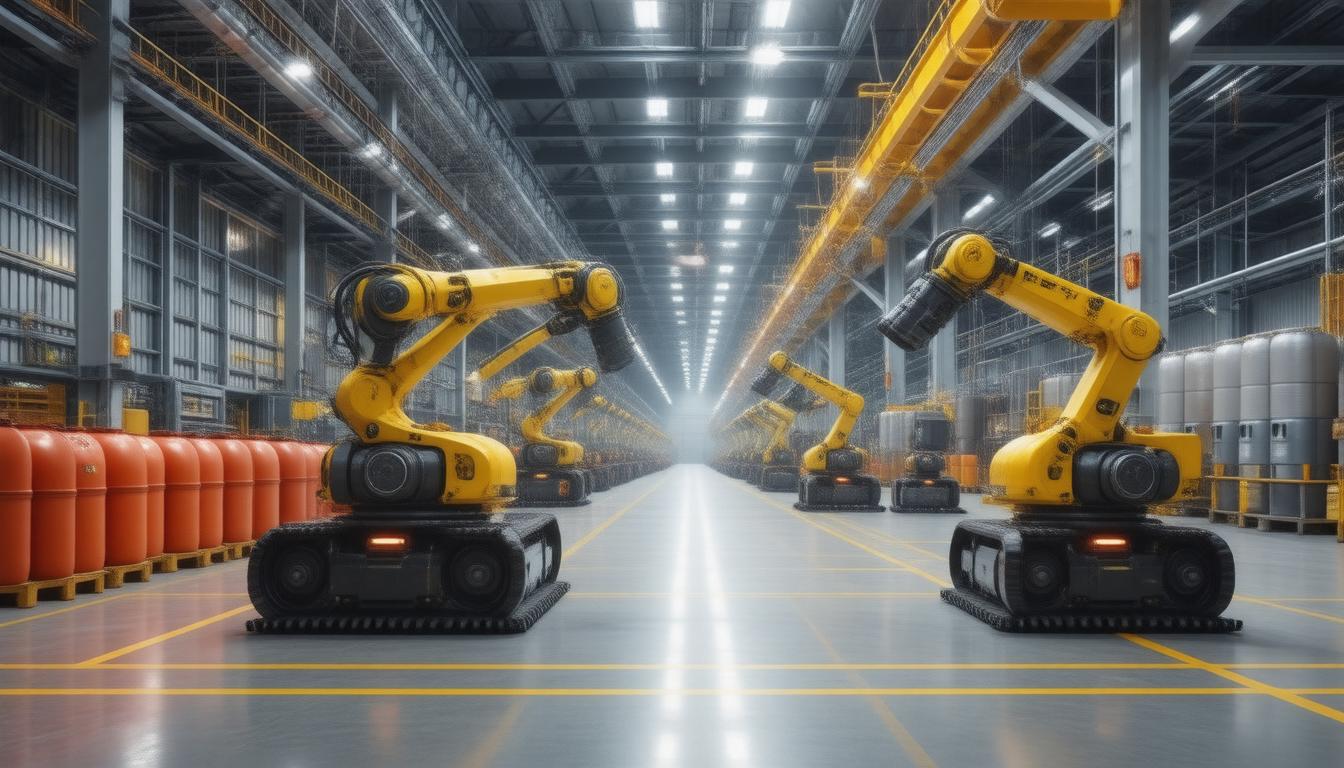
In an era where technology is rapidly reshaping various industries, the integration of AI in hazardous material handling safety is paving the way for revolutionary advancements.
The management of hazardous materials has always been a critical concern due to the potential risks they pose to human health and the environment.
However, with the advent of artificial intelligence, companies are now able to enhance safety protocols, minimize risks, and ensure compliance with stringent regulations.
This article explores the role of AI in improving safety measures in hazardous material handling, highlighting its importance, the technologies at play, real-world applications, challenges faced, and potential future trends that could further enhance safety in industrial settings.
Transform Your Safety Management with AI-Powered Tools
Key Takeaways
- AI is becoming a crucial tool in enhancing safety protocols for hazardous material handling.
- The importance of safety management in hazardous environments cannot be overstated, as it protects workers and the environment.
- Successful AI implementations in hazardous materials have demonstrated significant safety improvements and risk reductions.
- Despite its benefits, there are challenges and limitations to integrating AI technologies in hazardous material handling.
- The future of AI in industrial safety looks promising, with continual advancements expected to further enhance safety measures.
Introduction to AI in Hazardous Material Handling
The integration of AI in hazardous material handling safety is revolutionizing the way industries manage risks associated with dangerous substances.
By employing advanced algorithms and machine learning, AI systems can analyze vast amounts of data in real-time, enhancing decision-making processes and improving safety protocols.
This technology plays a critical role in monitoring hazardous environments, predicting potential hazards, and automating processes that traditionally required human intervention.
As organizations strive to minimize accidents and comply with stringent regulations, the implementation of AI in hazardous material handling safety not only boosts operational efficiency but also significantly enhances workplace safety.
In this article, we will explore how AI is transforming hazardous material management and the implications for safety in the workplace.
The Importance of Safety in Hazardous Material Management
In the realm of hazardous material management, the integration of AI in hazardous material handling safety is becoming increasingly vital.
As industries deal with toxic substances daily, ensuring the safety of personnel and the environment is paramount.
AI technologies can analyze vast amounts of data to identify potential hazards, predict safety risks, and recommend best practices for handling these materials.
For instance, through machine learning algorithms, AI can monitor equipment performance and detect anomalies that may lead to accidents.
Additionally, AI-driven predictive analytics can foresee workplace incidents, allowing companies to implement preventive measures before accidents occur.
This proactive approach not only enhances workplace safety but also helps organizations comply with regulations and reduce costs associated with hazardous material incidents, making AI an indispensable tool in modern hazardous material management.
‘The greatest danger in times of turbulence is not the turbulence; it is to act with yesterday’s logic.’ – Peter Drucker
Transform Your Safety Management with AI-Powered Tools
How AI Technologies Enhance Safety Protocols
In today’s rapidly evolving industrial landscape, the implementation of AI in hazardous material handling safety is transforming the way organizations manage risk and protect their workforce.
AI technologies enhance safety protocols by providing real-time data analysis, predictive maintenance, and automated monitoring systems that significantly reduce human error.
For instance, AI-driven sensors can detect leaks or breaches in containment systems, alerting personnel before accidents occur.
Furthermore, machine learning algorithms assess vast amounts of historical data to identify potential hazards and suggest preventative measures tailored to specific environments.
This proactive approach not only safeguards employee health but also ensures compliance with stringent safety regulations.
By integrating AI into their safety protocols, businesses can create a more resilient operational framework that prioritizes worker safety while optimizing efficiency in hazardous material handling.
Case Studies: Successful AI Implementations in the Field
Artificial Intelligence (AI) is revolutionizing various industries, and one of the most critical applications is in hazardous material handling safety.
Several organizations have successfully implemented AI solutions to improve their safety protocols and enhance efficiency.
For instance, a prominent chemical manufacturing plant employed AI systems to monitor and analyze environmental data in real-time.
This implementation not only reduced the risk of chemical spills but also allowed for predictive maintenance of equipment, ultimately decreasing downtime and ensuring employee safety.
Additionally, a waste management company adopted AI-powered robots to automate the sorting of hazardous materials.
These robots utilize computer vision to identify and separate hazardous waste from recyclables, thereby minimizing human exposure to dangerous substances.
Such case studies highlight the transformative impact of AI in hazardous material handling safety, demonstrating that smart technologies can not only streamline operations but also significantly improve the safety of workers in potentially dangerous environments.
Challenges and Limitations of AI in Hazardous Material Handling
While the integration of AI in hazardous material handling safety presents promising advancements, it is essential to recognize the challenges and limitations that accompany this technology.
One of the primary concerns is the accuracy and reliability of AI algorithms when processing complex data sets.
In hazardous environments, even minor errors can lead to significant safety risks, underscoring the need for continuous learning and adaptation of AI systems.
Additionally, the lack of standardized protocols for AI implementation can lead to inconsistencies in performance across different settings, making it difficult to ensure uniform safety measures.
Another challenge is the potential for AI to misinterpret sensor data, which could result in incorrect assessments of risk or inadequate responses to hazardous situations.
Furthermore, integrating AI solutions often requires substantial investments in technology and employee training, which can be a barrier for some organizations.
Despite these challenges, the ongoing development of AI in hazardous material handling safety continues to be an area of critical research and improvement, aiming to enhance workplace safety and operational efficiency.
Future Trends: The Next Steps for AI and Safety in Industrial Settings
As industries continue to embrace technological advancements, the integration of AI in hazardous material handling safety is becoming increasingly vital.
Future trends indicate that AI will play a crucial role in enhancing operational safety by utilizing real-time data analysis to predict potential hazards and streamline response protocols.
This proactive approach not only minimizes risks associated with hazardous materials but also boosts overall efficiency by automating various safety checks and compliance measures.
As machine learning algorithms evolve, they will enable predictive maintenance of equipment, ensuring that machinery involved in handling dangerous substances operates under optimal conditions.
Furthermore, the implementation of AI-driven training programs will provide workers with sophisticated simulations of emergency scenarios, thus improving their preparedness and response times in real-life situations.
Overall, the future of AI in hazardous material handling safety holds promise, paving the way for safer industrial environments and reducing the likelihood of accidents and injuries.
Frequently Asked Questions
What is AI and how does it apply to hazardous material handling?
AI, or artificial intelligence, refers to the simulation of human intelligence in machines that are programmed to think and learn.
In hazardous material handling, AI can analyze data, predict risks, and enhance safety protocols, making operations safer and more efficient.
Why is safety important in hazardous material management?
Safety in hazardous material management is critical to protect workers, the environment, and the community.
Mishandling hazardous materials can lead to accidents, health risks, environmental damage, and significant financial losses.
What are some examples of AI technologies used in hazardous material handling?
Examples of AI technologies in hazardous material handling include predictive analytics for risk assessment, robotics for material transport, machine learning for identifying unsafe conditions, and real-time monitoring systems that enhance decision-making.
What challenges does AI face in hazardous material handling?
Challenges include the integration of AI with existing systems, data privacy concerns, the need for skilled personnel to manage AI technologies, and the variability in regulatory environments across different regions.
What does the future hold for AI in hazardous material handling safety?
The future of AI in hazardous material handling looks promising, with ongoing advancements expected in machine learning algorithms, increased automation, enhanced predictive capabilities, and continued improvements in safety protocols, driving efficiency and safety in industrial settings.





